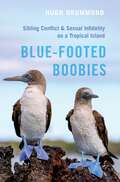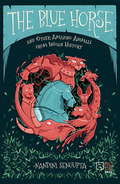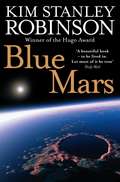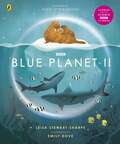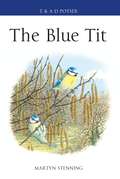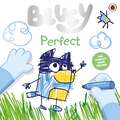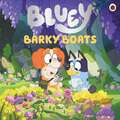- Table View
- List View
Blue-Footed Boobies: Sibling Conflict and Sexual Infidelity on a Tropical Island
by Hugh DrummondIn Blue-Footed Boobies, Hugh Drummond presents a lifetime field study of one of the planet's most charismatic and observable birds, focused on two themes of human relevance: aggressive competition between siblings and monogamous pair-bonding combined with frequent infidelity. In an account peppered with research anecdotes, he immerses readers in a bustling blue-footed booby colony where social manipulation and life-and-death dramas are the stuff of family life. Here, dominant elder chicks prefer to bully their siblings into abject submission rather than killing them and younger siblings' susceptibility to subordination is an evolved ability. The narrative expands to survey the colorful strategies used by young birds and mammals to compete with siblings ruthlessly, with restraint or with courtly manners, scrutinize the role of parents in sibling conflict, and assess the lifetime impacts of bullying on those that survive. Next, a compelling eye-witness account of monogamous partnerships in blue-foots reveals a world disturbingly familiar to humans. After displaying their beauty and physical prowess to each other, females and males select partners and commit to months of relentless parental care, sharing duties and making decisions jointly. Half of them renew their bond the following year, and renewers are more efficient and successful than first-time partners. But colonies of bonded blue-foot pairs are hotbeds of infidelity! Nearly all females and males carry on semi-secret liaisons with 1-3 neighbors, roughly one third of them copulate repeatedly with those extra partners, and one in ten males ends up caring for another male's chick. Countermeasures include surveillance, aggression and partner-switching, and males unsure of paternity sometimes resort to infanticide. Drummond discusses a panoply of plausible biological functions of infidelity. Sibling competition and sexual conflict are widespread in animal species in which two partners raise contemporaneous offspring together, and notorious in humans. In the final chapter Drummond argues for a common evolutionary cause in the blue-foot and human lineages, despite the psychology of their behavior being quite different: whereas boobies thoughtlessly follow routines of predictable actions, humans experience inclinations and urges they can implement in diverse ways, or choose to veto.
The Blue-Footed Booby
by Rob BiddulphThe newest picture book written and illustrated by the bestselling and award-winning Rob Biddulph, the creative star behind the viral and phenomenal #DrawWithRob!
The Blue Horse and Other Amazing Animals from Indian History
by Nandini SenguptaIt’s not just humans who make history, you know. So move over, chroniclers and historians. For centuries, we’ve been ignored, forgotten, occasionally footnoted (thanks a lot). It’s time we took centre stage. Strongest allies, faithful friends…we’ll even go so far as to say we were the soulmates of great kings and queens, princes and princesses, warriors and administrators. From saving their lives (while putting ours at risk) and leading them to victory in war to being a constant source of joy and love, we’ve done it all. Take a tour of Akbar’s dazzling court with his favourite cheetah, Samand Manik. Learn about the heroic battle of Haldighati – straight from Chetak’s mouth. Find out what Chhatrapati Shivaji was really like – from his dog, Waghya. Full of daring exploits, epic romances and heart-wrenching moments, these underdog (oh calm down, Bucephalus, it’s just a term!) stories are unlike anything you’ve ever read before!
Blue Light Effects in Biological Systems (Proceedings in Life Sciences)
by H. SengerFour years ago The Blue Light Syndrome was published as the Proceed ings of the 1 st International Conference on the Effect of Blue Light in Plants and Microorganisms. Subsequently the interest in this fascinating and growing field of re search has further increased, as is reflected by numerous publications. Blue light effects cover such a wide spectrum of organisms, responses and methods that communication among scientists with backgrounds in biology, biochemistry, and biophysics is particularly necessary. These facts not only justified, but demanded calling the "Blue Light Family" together again. In spite of many fmancial problems, the second confer ence attracted 113 active members from 19 countries. The 2nd International Conference on The Effect of Blue Light in Plants and Microorganisms was held in July 1984, like the first at the University of Marburg. The organizer could again rely on the help of the International Advisory Committee (W. Briggs, Stanford; M. Furuya, Tokyo; J. Gressel, Rehovot; S. Miyachi, Tokyo; W. Rau, Miinchen; J. Schiff, Waltham; P .-S. Song, Lubbock). The very generous financial as sistance from the DFG and the support of the Philipps-Universitat Mar burg and its Sonderforschungsbereich "Zellenergetik and Zelldifferen zierung" were the prerequisites to organizing the conference. The present book consists of 56 original papers. The partitioning into eight chapters is always a problem. The grouping of different aspects of the papers into these chapters has not always been obvious, so that one or the other contribution could possibly fit in another chapter.
Blue Mars: Red Mars, Green Mars, Blue Mars (Mars Trilogy Ser. #3)
by Kim Stanley RobinsonThe final novel in the worldwide bestselling Mars trilogy, now part of the Voyager Classics collection.
Blue Meridian: The Search For The Great White Shark (Classic, Nature, Penguin Ser.)
by Peter MatthiessenIn 1969 Peter Matthiessen set out with the expedition led by Peter Gimbel, whose aim was to find and film underwater for the first time the most dangerous of all sea creatures - the great white shark. Acting as the expedition's chronicler and spare hand (both on the surface and below), Matthiessen accompanied the crew from the Carribean to the whaling grounds off the Durban coast, to various islands in the Indian Ocean, to Ceylon, and finally to success off the bleak south coast of Australia.Blue Meridian records the awesome experience of swimming in open water among hundreds of sharks, the beauties of strange seas and landscapes and the camaraderie, humour and tension of people who live in close proximity and risk their lives day by day.
Blue Planet II: For young wildlife-lovers inspired by David Attenborough's series (BBC Earth)
by Leisa Stewart-SharpeThis is our Blue Planet: a beautiful blue marble suspended in a sea of stars.Unlike billions of other worlds in the Milky Way, 71 per cent of our Blue Planet is covered by ocean. It's home to the greatest diversity of life on Earth but is our least explored habitat; we've better maps of Mars than of the ocean floor.With so much more to discover, take a deep breath . . . and dive into a wondrous world beneath the waves.Explore coral reefs that shimmer in a kaleidoscope of colours.Venture to the bottom of the ocean where creatures beyond your wildest imagination live in the dark.Chase sea otters through kelp forest seas, and glide the open ocean with humpback whales.Discover all there is to love about our Blue Planet, the stories of its inhabitants, and realise how you can help protect this wilderness beneath the waves.In collaboration with BBC Earth, this illustrated non-fiction book will capture the wonder, beauty, and emotion of the landmark Blue Planet II TV series.
The Blue Tit
by Martyn StenningSporting a mix of blue, yellow, white, green and black, the unmistakable Blue Tit reflects the colours of a planet affected by a burgeoning human population. Fortunately, Blue Tits are adapting well to modern humanity, taking advantage of our propensity to feed birds in our gardens and provide boxes for them to nest in. In turn, this feisty little species provides an excellent model for biological research. This book is the result of a personal quest by author Martyn Stenning to bring together a range of discoveries into one accessible volume.The Blue Tit begins by inviting readers into the intimate lives of these birds as they attempt to reproduce, describing the many challenges they face when rearing their offspring. The story moves on to the fluid state of Blue Tit classification across the native Palearctic range, before progressing into population structure, lifetime ecology and an exploration of factors that determine breeding success. It culminates with an in-depth look at research over the years, followed by a selection of personal anecdotes and an overview of Blue Tit appearances in folklore and poetry.This book provides a definitive record of the biology and ecology of one of our most popular, intelligent and charismatic birds.
The Blue Tit
by Martyn StenningSporting a mix of blue, yellow, white, green and black, the unmistakable Blue Tit reflects the colours of a planet affected by a burgeoning human population. Fortunately, Blue Tits are adapting well to modern humanity, taking advantage of our propensity to feed birds in our gardens and provide boxes for them to nest in. In turn, this feisty little species provides an excellent model for biological research. This book is the result of a personal quest by author Martyn Stenning to bring together a range of discoveries into one accessible volume.The Blue Tit begins by inviting readers into the intimate lives of these birds as they attempt to reproduce, describing the many challenges they face when rearing their offspring. The story moves on to the fluid state of Blue Tit classification across the native Palearctic range, before progressing into population structure, lifetime ecology and an exploration of factors that determine breeding success. It culminates with an in-depth look at research over the years, followed by a selection of personal anecdotes and an overview of Blue Tit appearances in folklore and poetry.This book provides a definitive record of the biology and ecology of one of our most popular, intelligent and charismatic birds.
Blue tit (Large Print)
by Rnib BookshareThis is an image of a European Blue Tit viewed from the side and facing left so that only one eye and one wing can be found. There is a locator dot shown, which will be at the top left of the page when the image is the right way up. The blue tit has distinctive and colourful plumage. It has a light blue 'crown' on top of its head, a white face with dark blue around it and a dark blue line going through its eyes. It has a yellow chest, green, blue and white wings and a blue tail. The bird is in the centre of the page. Its head is at the top centre with its small grey beak to the left and its eye to the right of this. Down the page is its chest on the left and wing on the right. At the bottom of the image are the bird's two grey legs, each with three toes pointing to the left and one to the right. Its small tail is on the right.
Blue tit (UEB Contracted)
by Rnib BookshareThis is an image of a European Blue Tit viewed from the side and facing left so that only one eye and one wing can be found. There is a locator dot shown, which will be at the top left of the page when the image is the right way up. The blue tit has distinctive and colourful plumage. It has a light blue 'crown' on top of its head, a white face with dark blue around it and a dark blue line going through its eyes. It has a yellow chest, green, blue and white wings and a blue tail. The bird is in the centre of the page. Its head is at the top centre with its small grey beak to the left and its eye to the right of this. Down the page is its chest on the left and wing on the right. At the bottom of the image are the bird's two grey legs, each with three toes pointing to the left and one to the right. Its small tail is on the right.
Blue tit (UEB Uncontracted)
This is an image of a European Blue Tit viewed from the side and facing left so that only one eye and one wing can be found. There is a locator dot shown, which will be at the top left of the page when the image is the right way up. The blue tit has distinctive and colourful plumage. It has a light blue 'crown' on top of its head, a white face with dark blue around it and a dark blue line going through its eyes. It has a yellow chest, green, blue and white wings and a blue tail. The bird is in the centre of the page. Its head is at the top centre with its small grey beak to the left and its eye to the right of this. Down the page is its chest on the left and wing on the right. At the bottom of the image are the bird's two grey legs, each with three toes pointing to the left and one to the right. Its small tail is on the right.
Blue Whale (large print)
by RnibThis image shows a whale seen from the side with its head on the bottom left of the page and its tail on the top right of the page. There is a locator dot shown, which will be at the top left of the page when the image is the correct way up. The whale's huge mouth is partly open showing the filaments it uses to filter the tiny shrimp-like creatures (krill) it feeds on from the seawater. To the right of the mouth is one of its two eyes. To the right again is the front leg, which has developed into a flipper for swimming. At the bottom of the image the whale's belly has longitudinal ridges. These are decorated with white spots (not shown on the tactile image). The massive body curves up and to the right. The tail is turned slightly towards you so both the left and right tail flipper can be found. The tail is curved up because the whale has just dived. The whale is a blue-grey in colour. There is a stick man for scale in the bottom right of the page. The Blue whale can grow to be 100 feet (31 metres) long and weigh 134 tons. By contrast an average adult African elephant weighs 4.5 tons. The blue whale is the largest living animal on the planet.
Blue Whale (UEB contracted)
by RnibThis image shows a whale seen from the side with its head on the bottom left of the page and its tail on the top right of the page. There is a locator dot shown, which will be at the top left of the page when the image is the correct way up. The whale's huge mouth is partly open showing the filaments it uses to filter the tiny shrimp-like creatures (krill) it feeds on from the seawater. To the right of the mouth is one of its two eyes. To the right again is the front leg, which has developed into a flipper for swimming. At the bottom of the image the whale's belly has longitudinal ridges. These are decorated with white spots (not shown on the tactile image). The massive body curves up and to the right. The tail is turned slightly towards you so both the left and right tail flipper can be found. The tail is curved up because the whale has just dived. The whale is a blue-grey in colour. There is a stick man for scale in the bottom right of the page. The Blue whale can grow to be 100 feet (31 metres) long and weigh 134 tons. By contrast an average adult African elephant weighs 4.5 tons. The blue whale is the largest living animal on the planet.
Blue Whale (UEB uncontracted)
by RnibThis image shows a whale seen from the side with its head on the bottom left of the page and its tail on the top right of the page. There is a locator dot shown, which will be at the top left of the page when the image is the correct way up. The whale's huge mouth is partly open showing the filaments it uses to filter the tiny shrimp-like creatures (krill) it feeds on from the seawater. To the right of the mouth is one of its two eyes. To the right again is the front leg, which has developed into a flipper for swimming. At the bottom of the image the whale's belly has longitudinal ridges. These are decorated with white spots (not shown on the tactile image). The massive body curves up and to the right. The tail is turned slightly towards you so both the left and right tail flipper can be found. The tail is curved up because the whale has just dived. The whale is a blue-grey in colour. There is a stick man for scale in the bottom right of the page. The Blue whale can grow to be 100 feet (31 metres) long and weigh 134 tons. By contrast an average adult African elephant weighs 4.5 tons. The blue whale is the largest living animal on the planet.
Bluebell (Large Print)
by Rnib BookshareThere are two views of a bluebell, a side view on the left and a front view on the right of the page. There is a locator dot shown, which will be at the top left of the page when the image is the right way up. The side view shows six blue, bell-shaped flower heads hanging one after another from the stem. They are pointing to the left and down. The open ends of the bells have part of the petal which curls back. Three of the six curls can be found on each of the flower heads. Down from the flower heads the stem continues to run down the page. There are two long, thin leaves to the right and three to the left of the stem. The front view shows four flower heads. There is a ring at the bottom of each flower head which is the opening to each bell. Four of the six curls can be found coming from this ring. The stem continues down the page for a short distance after the bottom flower head. Each flower head is approximately fifteen millimetres long. The plant usually grows to a height of approximately twenty centimetres.
Bluebell (UEB Contracted)
by Rnib BookshareThere are two views of a bluebell, a side view on the left and a front view on the right of the page. There is a locator dot shown, which will be at the top left of the page when the image is the right way up. The side view shows six blue, bell-shaped flower heads hanging one after another from the stem. They are pointing to the left and down. The open ends of the bells have part of the petal which curls back. Three of the six curls can be found on each of the flower heads. Down from the flower heads the stem continues to run down the page. There are two long, thin leaves to the right and three to the left of the stem. The front view shows four flower heads. There is a ring at the bottom of each flower head which is the opening to each bell. Four of the six curls can be found coming from this ring. The stem continues down the page for a short distance after the bottom flower head. Each flower head is approximately fifteen millimetres long. The plant usually grows to a height of approximately twenty centimetres.
Bluebell (UEB Uncontracted)
by Rnib BookshareThere are two views of a bluebell, a side view on the left and a front view on the right of the page. There is a locator dot shown, which will be at the top left of the page when the image is the right way up. The side view shows six blue, bell-shaped flower heads hanging one after another from the stem. They are pointing to the left and down. The open ends of the bells have part of the petal which curls back. Three of the six curls can be found on each of the flower heads. Down from the flower heads the stem continues to run down the page. There are two long, thin leaves to the right and three to the left of the stem. The front view shows four flower heads. There is a ring at the bottom of each flower head which is the opening to each bell. Four of the six curls can be found coming from this ring. The stem continues down the page for a short distance after the bottom flower head. Each flower head is approximately fifteen millimetres long. The plant usually grows to a height of approximately twenty centimetres.
The Bluefin Tuna Fishery in the Bay of Biscay: Its Relationship with the Crisis of Catches of Large Specimens in the East Atlantic Fisheries from the 1960s (SpringerBriefs in Biology)
by José Luis Cort Pablo AbaunzaThis open access book is an original contribution to the knowledge on fishing and research associated with one of the most enigmatic fish of our seas: bluefin tuna, Thunnus thynnus (L.). Based on available evidence, it reconstructs the possible methods used to catch large spawners in the Strait of Gibraltar thousands of years ago and describes the much more recent overfishing that led to a great reduction in the catches of the trap fishery on the area and the disappearance of the northern European fisheries. It is the first book to relate the overfishing of juvenile fishes in certain areas to the decline of large spawners in other very distant areas, revealing one of the main underlying causes of this decline, which has remained a mystery to the fishing sector and scientists alike for over 50 years. This finding should serve to prevent similar cases from arising in the future.
Bluey: A Search-and-Find Book
by BlueyHave you seen Bluey and Bingo?Join Bluey on the beach, in the backyard and at the park in this jam-packed search-and-find activity book. With over 140 items to spot, this book is perfect for keeping the biggest Bluey fans busy.
Bluey: Celebrate Father’s Day with Bluey and Bingo! (Bluey)
by BlueyBluey and Bingo are drawing Father's Day cards for Dad.Bluey wants hers to be perfect but soon realises perfect is tough. It's a good thing Bluey is tough!A gorgeous picture book about how sometimes perfect doesn't have to be . . . perfect?Want more Bluey? Also available:Bluey: SleepytimeBluey: Bob BilbyBluey: Charades
Bluey: Baby Race (Bluey)
by BlueyMum tells Bluey a lovely baby story - about how Bluey first learned to walk!Baby Bluey could roll, shuffle and even crawl backwards... but Mum was worried that she was never going to learn how to walk.This hilarious picture book is about how we all grow up in different ways.What other adventures will you go on with Bluey? Also Available:Bluey: Daddy PutdownBluey: CampingBluey: Mum SchoolBluey: Christmas SwimBluey: Easter
Bluey: Bad Mood (Bluey)
by BlueyBingo is in a bad mood today and begins to cause chaos in the Heeler house.Bluey tries to make her happy again with some of her favourite things. Will Bluey and Mum be able to cheer her up before she destroys the house?Stomp out the bad mood feeling with Bingo and Bluey in this new picture book story!What other adventures will you go on with Bluey? Also Available:Bluey: Daddy PutdownBluey: CampingBluey: PerfectBluey: Barky BoatsBluey: Mum School
Bluey: Barky Boats (Bluey)
by BlueyBluey and Mackenzie are spending the day with their buddies. They're excited to play Barky Boats and build a fairy garden! Their buddies Mia and Captain seem distracted - will they still have time to play with Bluey and Mackenzie?A gorgeous picture book about big adventures and growing up.What other adventures will you go on with Bluey? Also available:Bluey: The CreekBluey: SleepytimeBluey: Grannies
Bluey: The Beach (Bluey)
by BlueyJoin Bluey for a fun day at the beach in this first picture book story from the new hit animation!Bluey, Bingo, Mum and Dad are at the beach. While Mum is off for a walk, Bluey discovers a beautiful shell and runs to catch up with her. What will she discover along the way in her first solo adventure?This new Bluey picture book is perfect for sharing with Bluey fans at storytime and bedtime.
